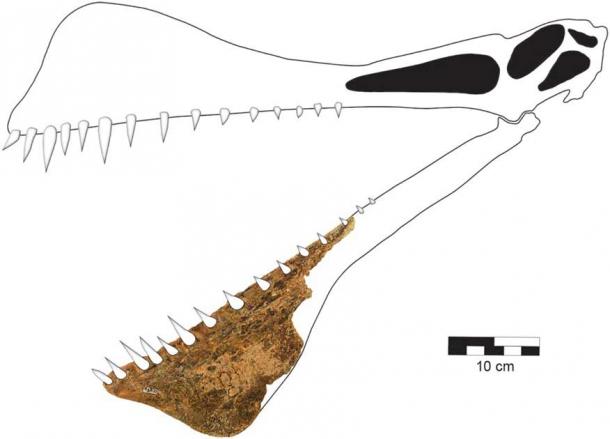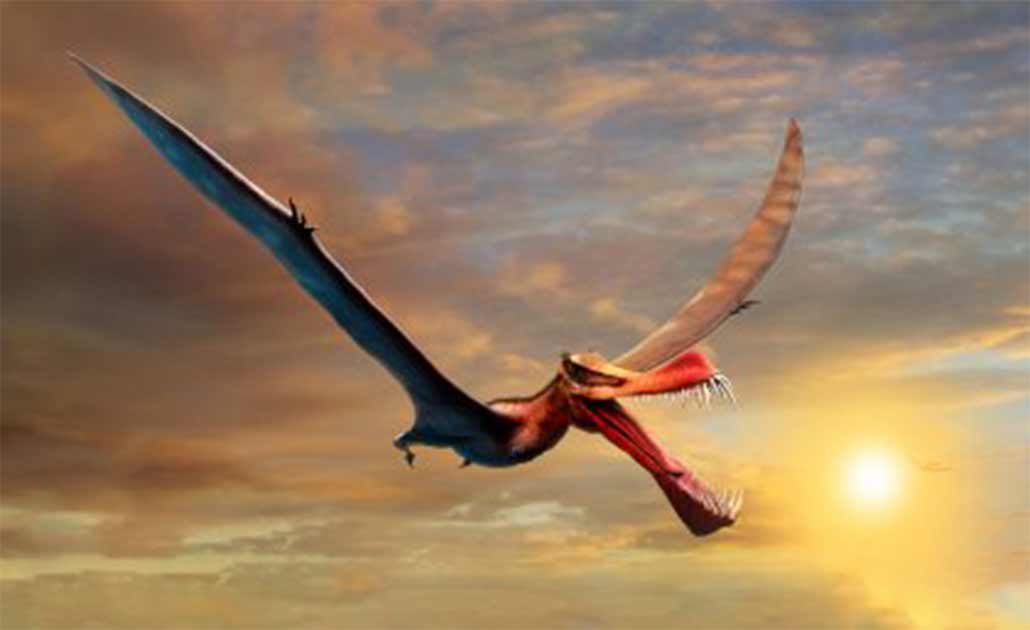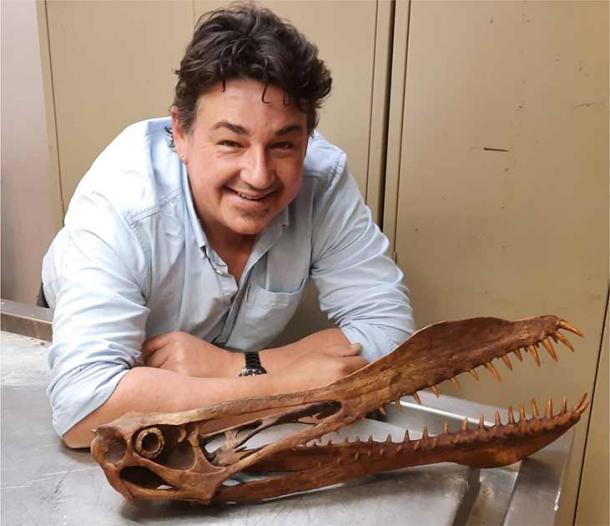

A gigantic prehistoric jawbone recovered near the small Australian outback town of Richmond in Northwest Queensland belonged to a previously undiscovered type of Australian pterosaur, a University of Queensland press release has announced. These giant winged dinosaurs were the largest creatures to ever patrol Earth’s skies. And this particular type of pterosaur would have been ancient Australia’s largest flying reptile.
This absurdly huge flying creature would have had a 23-foot (seven-meter) wingspan when its wings were fully extended. Its skull was approximately three feet (one meter) long, elongated and spear-shaped at the end. It would have had about 40 razor-sharp teeth, making it an efficient and highly effective predator that probably thrived on catching fish.
“It’s the closest thing we have to a real-life dragon,” exclaimed Tim Richards, a University of Queensland PhD candidate who led the School of Biological Sciences Dinosaur Lab study that identified the creature’s fossilized remains.

University of Queensland PhD candidate Tim Richards posing with a model of the Australian pterosaur which was reconstructed from the fossil of the creature’s jaw, found in a quarry just northwest of Richmond in June 2011 by Len Shaw, a local fossicker. (The University of Queensland)
Largest Australian Pterosaur Is Named Thapunngaka shawi
“The new pterosaur, which we named Thapunngaka shawi, would have been a fearsome beast,” Richards continued. “It was essentially just a skull with a long neck, bolted on a pair of long wings … this thing would have been quite savage.”
These flying dinosaurs didn’t leave too many fossils around. Less than 20 Australian pterosaur bones have been found: all in the same general area of Queensland. The previously discovered bones all belonged to two different (and smaller) pterosaur species, which is why the fossil detectives were so surprised and delighted when they realized they were looking at a fossil that didn’t quite match those other finds.
The prehistoric specimen, which included the lower but not the upper half of the creature’s jawbone, was found in a quarry near Richmond in June 2011 by local fossil hunter Len Shaw. It was the biggest thing he ever found, both figuratively and literally. It wasn’t until Tim Richards came along and looked at it with fresh eyes that anyone realized it didn’t quite fit (again, both figuratively and literally) with the other pterosaur bones found in the area.
The name of the new species is derived from the ancient language of the indigenous Wanamara Nation (the fossilized jawbone was found on Wanamara land).
“The genus name, Thapunngaka, incorporates thapun [ta-boon] and ngaka [nga-ga], the Wanamara words for ‘spear’ and ‘mouth’, respectively,” explained Dr. Steve Salisbury, Tim Richards’ PhD supervisor and co-author of an article about the new study that appeared in Journal of Vertebrate Paleontology.
As for the Shawi part of the pterosaur’s new name ( Thapunngaka shawi), that is obviously in reference to the fossil’s discoverer, whose name has now been permanently affixed to an entire species of dinosaur.

The neck of Anhanguera pterosaurs was longer than the torso, as this reconstruction from a museum exhibit makes very clear. And this type of pterosaur fed strictly on fish and seafood. (Tim Evanson / CC BY-SA 2.0)
A Fish-Eating Dinosaur in the Australian Outback?
Unlike many types of pterosaur, the Australian pterosaurs presented no threat to land animals. They belonged to a class of pterosaur known as anhanguera, which means they fed strictly on fish and seafood. This type of pterosaur was not around in the earliest part of the Age of the Dinosaurs but evolved in the Cretaceous Period (145 million years ago to 66 million years ago).
Anhanguerian pterosaurs were talented and prolific fishers. An anhanguerian would glide back and forth over open water before swooping down from the sky in a flash, poking its sharp beak deep into the water to grab and extract whatever swimming creature it had spotted from above.
It might seem odd that the fossilized jawbone of a fish-eating dinosaur would be found in the super-dry Australian outback. But during the Cretaceous Period, the eastern interior of Australia was covered by a wide, shallow inland ocean known as the Eromanga Sea. Its clear waters hosted an incredible variety of fish, shellfish, turtles, mussels, primitive squid, and long-extinct marine reptile species.
This ocean would have made an incredible feeding ground for flying dinosaurs that knew how to fish, which explains why at least three species of anhanguerian pterosaur chose to live along its shores.
Despite its similarities to the flying creatures of today, Thapunngaka shawi was unique.

Reconstruction of the skull of Thapunngaka shawi, the largest Australian pterosaur ever, from the original fossil fragment found by Len Shaw. This pterosaur’s powerful and wide jaws would have been perfect for grabbing fish. (Journal of Vertebrate Paleontology)
“It was nothing like a bird, or even a bat,” Richards said. “Pterosaurs were a successful and diverse group of reptiles—the very first back-boned animals to take a stab at powered flight.”
Anhanguerian pterosaurs were found on every continent during the Cretaceous Period. While their thin-walled and hollow bones were perfect for flight, those bones were more brittle and less durable than those of dinosaurs that lived on land. Consequently, they left behind few fossilized remains, and many of the remains they did leave behind were heavily decayed or broken into small pieces.
“It’s quite amazing fossils of these animals exist at all,” Mr Richards said. “By world standards, the Australian pterosaur record is poor, but the discovery of Thapunngaka contributes greatly to our understanding of Australian pterosaur diversity.”

An artist’s 3D illustration of a pterosaur dinosaur carrying a large fish in its jaws. (warpaintcobra / Adobe Stock)
Too Big to Fail
From a timeline perspective, human existence is like a single blink of an eye, when compared to how long pterosaurs ruled the planet’s skies. These fierce airborne reptilian predators were around for more than 160 million years, only disappearing 66 million years ago during the great extinction event that killed off all species of dinosaurs.
As long as there were dinosaurs on the earth the gigantic pterosaurs were there, their security ensured by their unique way of tracking and capturing prey, and by the fact they were too big to be bothered by other predators. They filled a broad niche in the global ecosystem and were able to survive in any location where temperatures were warm and food was plentiful.
Thapunngaka shawi was an unusually large creature, even by normal pterosaur standards. The fishing must have been really good in the Eromanga Sea during the Cretaceous Period, providing a steady enough supply of high-quality protein over millions of years to allow these flying dinosaurs to evolve to such an astonishing size.
Given the fact that only one of their fossils has so far been found, there’s no way to tell exactly how big the typical Thapunngaka shawi actually might have been. A 23-foot/seven-meter wingspan sounds impressive, but for all anyone knows it might have been well below average for this particular species.